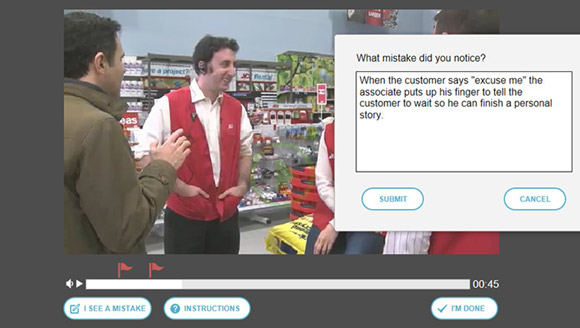There’s a new elearning example on our website using a funny interactive video.
It shows a customer looking for help in a hardware store and the learners’ task is to identify where service is lacking. At the end, the learner compares his/her responses with the expert responses.
Branching scenario vs. interactive video
A common learning-by-doing approach for customer service training would be a branching scenario where the learner chooses what to ‘say’ at each step. The video-based example takes a different approach; the learner isn’t choosing what to say, but instead must critique others. But which approach is more effective?
I think it depends on context. If analysis shows that learners are saying the wrong thing due to a common misconception, a branching scenario that allows learners make mistakes and see the consequence would probably be effective. But what if learners know what they should be saying, but just aren’t doing it?
For example, in the customer service video, most employees would know it’s not OK to ignore the customer while talking with colleagues. In this case, a branching scenario with obvious correct choices may seem superficial. In this context, an engaging video may be more effective for changing learners’ behaviors. And the added interactivity that requires learners to capture what they observe turns a passive exercise into an interactive one that is more likely to be remembered and applied.
Validation and feedback
What about the feedback? In our example, the learners’ responses aren’t validated – but they could be. What do you think? Can a self-evaluation like the one in the example be effective, or will learners take the easy way out and not make thoughtful comments? Does it depend on the motivation level of your learners?
We’ll soon be adding this video interaction as a SmartBuilder template, so if you have ideas for making this interaction better, or other ideas for video-based templates, let us know!



Leave a Reply